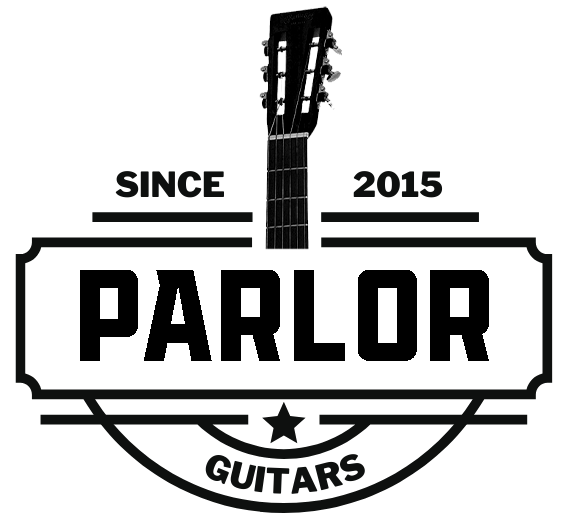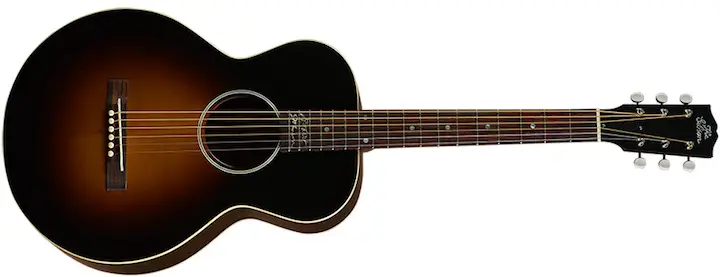From his humble beginnings to influencing iconic guitar players, Robert Johnson is now a name that most, if not all guitarists have heard of. Incidentally, his weapon of choice for his brand of delta blues is a 1926 Gibson L-1, a parlor shape guitar which has been immortalized by his influential recordings and iconic photos.
Interestingly, the L-1 had an archtop body back in 1902 when it was originally released, but was turned into a flat top acoustic with a smaller body in 1926. This parlor style body became the guitar of choice for many guitarists because of its midrange focused sound, which works great for blues and slide guitar playing. As expected, Gibson honored Johnson’s legacy with a signature version that makes the old design available for today’s players.
The Gibson Robert Johnson L-1 follows after the original in terms of look and tone. It has a solid sitka spruce top supported by x-bracing and mahogany back and sides, crafted into the L-1’s distinctive shape that is smaller than regular dreadnought and concert guitars. This particular combination gives the guitar the characteristic boxy “growl” expected of a blues box, while having a more reliable and durable structure, thanks to modern building and production technology.
The neck is crafted from mahogany and features a modified V profile that makes playing feel familiar and comfortable. It has a scale length of 25″ and a nut width of 1.75″, following the specs of original L-1s from the late 1920s. Like many Gibson guitars, the headstock is angled (17 degrees) and features a mother of pearl Gibson logo and a discrete black truss rod cover.
Check out the demo video below to see the Robert Johnson L-1 in action:
The demo video showcases the guitar’s genuine vintage appeal, and the tone is definitely something else. It would certainly feel great to play his classic “Crossroads” deltablues track on this guitar. Now if only Epiphone would make a mass production affordable version of the L-1, more players will get to appreciate the instrument.
Other features include mother of pearl dots fretboard inlay, bone nut and saddle, rosewood bridge, single-ply binding for the top and back, traditional multi-ply single rosette ring and vintage style tuners with white buttons. Finally, Robert Johnson’s signature is inlayed into the last two upper frets.
The Gibson Robert Johnson L-1 has an MSRP of $2699.



13 thoughts on “Gibson Robert Johnson L-1”
Hey, I don’t think Johnson would have posed with a prop anyway. And all these guys had a lot of bad habits; drinkin’, gamblin’, women. He could have won that in a poker game. Lightnin’ Hopkins was constantly hocking his guitars to gamble, and the pawn shop was always a good place to pick up a good deal on a guitar when you were flush. I can think of only one blues man who appears to have played the exact same guitar practically his whole life and that’s John Hurt. Everybody else went through guitars like they did women. Actually, I think John Hurt spent his whole life at home with one woman and one guitar. But Johnson was definitely not in that mold.
The L1 that Robert is holding in the famous photo was probably a prop of the photo studio. There is no oral evidence anywhere that he owned the L1. It would have been way out of his price range. Which makes the Gibson Robert Johnson guitar doubly ironic!
That’s an interesting take on his iconic photo with the Gibson L1. Still, the keyword here is “probably”. In my opinion, it is more probable that it is what it is, a bluesman who is photographed with his instrument, like many other bluesmen who loves their guitar.
Yes, It’s pretty well established by interviews with Shine and others that Robert Johnson played and recorded on the Kalamazoo K-18
Eh. The L-1’s list price in 1926 was $50. That’s about $745 in today’s money, which wouldn’t buy even the cheapest Gibson in current production. Pretty doable for someone even just north of homeless. Also, if it was a studio prop, wouldn’t we see it in other images from that studio during that era?
Yes, you are spot on! Furthermore, there are a few other photos of Robert with the same guitar that I saw in a blues documentary years ago.
That is correct!
I would rather think in his case that the so called prop L-1 must be his . He is after all the Muso , and why would a photographic studio own a guitar that was to expensive for him but good to be be used as just a so called prop?
Get that, Bob Cassidy! :p